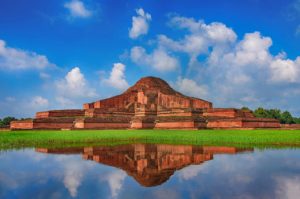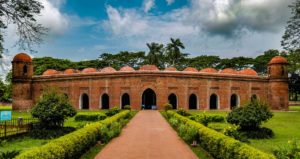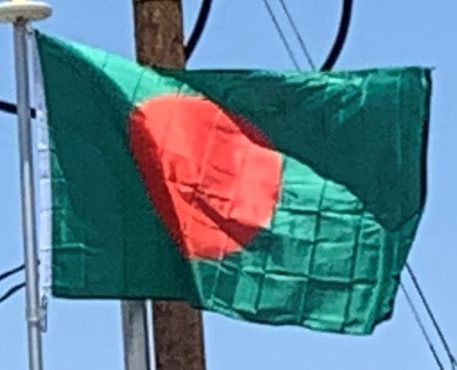
Greek and Roman records of the ancient Gangaridai Kingdom, which (according to legend) deterred the invasion of Alexander the Great, are linked to the fort city in Wari-Bateshwar. The site is also identified with the prosperous trading center of Souanagoura listed on Ptolemy’s world map. Roman geographers noted a large seaport in southeastern Bengal, corresponding to the present-day Chittagong region.
Ancient Buddhist and Hindu states which ruled Bangladesh included the Vanga, Samatata and Pundra kingdoms, the Mauryan and Gupta Empires, the Varman dynasty, Shashanka’s kingdom, the Khadga and Candra dynasties, the Pala Empire, the Sena dynasty, the Harikela kingdom and the Deva dynasty. These states had well-developed currencies, banking, shipping, architecture and art, and the ancient universities of Bikrampur and Mainamati hosted scholars and students from other parts of Asia. Xuanzang of China was a noted scholar who resided at the Somapura Mahavihara (the largest monastery in ancient India), and Atisa traveled from Bengal to Tibet to preach Buddhism. The earliest form of the Bengali language began to the emerge during the eighth century.
Early Muslim explorers and missionaries arrived in Bengal late in the first millennium CE. The Islamic conquest of Bengal began with the 1204 invasion by Bakhtiar Khilji; after annexing Bengal to the Delhi Sultanate, Khilji waged a military campaign in Tibet. Bengal was ruled by the Delhi Sultanate for a century by governors from the Mamluk, Balban and Tughluq dynasties. During the 14th century, an independent Bengal Sultanate was established by rebel governors. The sultanate’s ruling houses included the Ilyas Shahi, Jalaluddin Muhammad Shah, Hussain Shahi, Suri and Karrani dynasties, and the era saw the introduction of a distinct mosque architecture and the tangka currency. The Arakan region was brought under Bengali hegemony. The Bengal Sultanate was visited by explorers Ibn Battuta, Admiral Zheng He and Niccolo De Conti. During the late 16th century, the Baro-Bhuyan (a confederation of Muslim and Hindu aristocrats) ruled eastern Bengal; its leader was the Mansad-e-Ala, a title held by Isa Khan and his son Musa Khan. The Khan dynasty are considered local heroes for resisting North Indian invasions with their river navies.

The Mughal Empire controlled Bengal by the 17th century. During the reign of Emperor Akbar, the Bengali agrarian calendar was reformed to facilitate tax collection. The Mughals established Dhaka as a fort city and commercial metropolis, and it was the capital of Mughal Bengal for 75 years. In 1666, the Mughals expelled the Arakanese from Chittagong. Mughal Bengal attracted foreign traders for its muslin and silk goods, and the Armenians were a notable merchant community. A Portuguese settlement in Chittagong flourished in the southeast, and a Dutch settlement in Rajshahi existed in the north.
During the 18th century, the Nawabs of Bengal became the region’s de facto rulers. The title of the ruler is popularly known as the Nawab of Bengal, Bihar and Orissa, given that the Bengali Nawab’s realm encompassed much of the eastern subcontinent. The Nawabs forged alliances with European colonial companies, which made the region relatively prosperous early in the century. Bengal accounted for 50% of the gross domestic product of the empire. By 1700, the Mughal economy surpassed Qing China and Europe to become the world’s largest and at the time Bengal accounted for 12% of the world’s GDP, which was larger than the share held by western Europe. The Bengali economy relied on textile manufacturing, shipbuilding, saltpeter production, craftsmanship and agricultural produce. Bengal was a major hub for international trade. For example, 80% of Dutch silk imports from Asia were from Bengal. Silk and cotton textiles from Bengal were worn in Europe, Japan, Indonesia and Central Asia.
